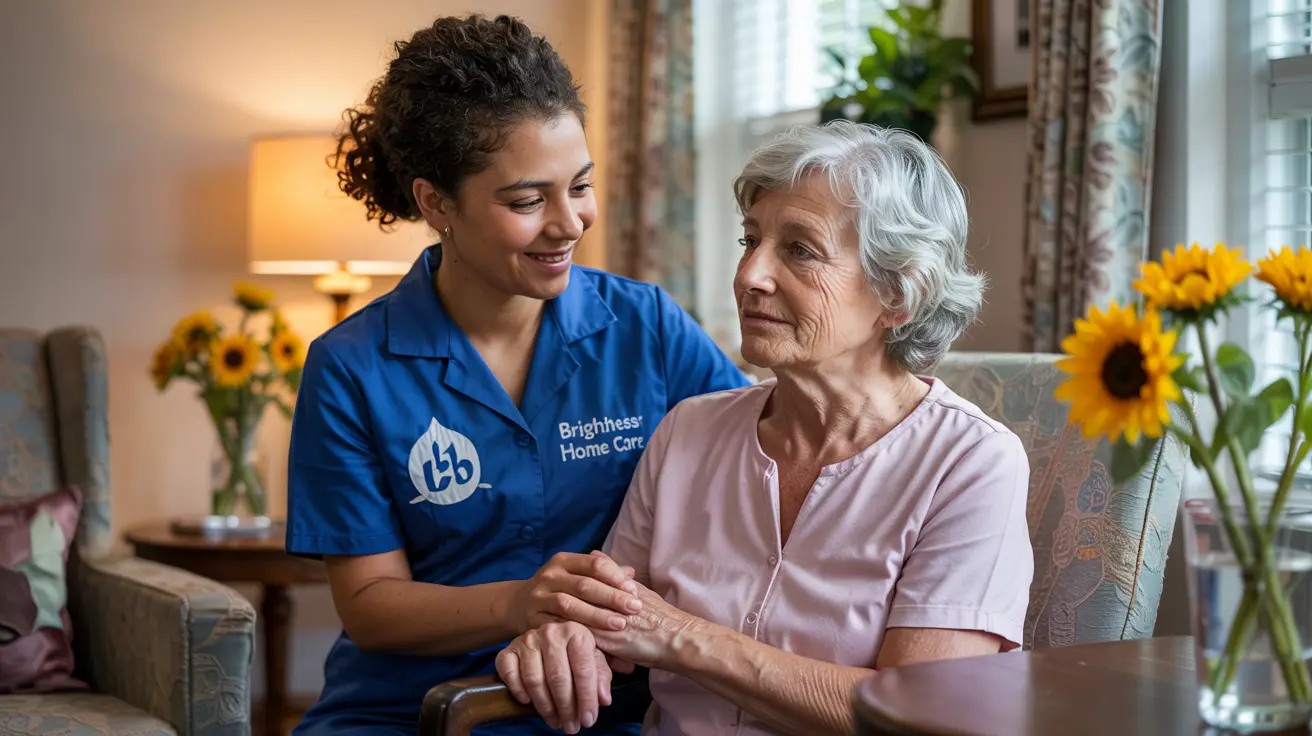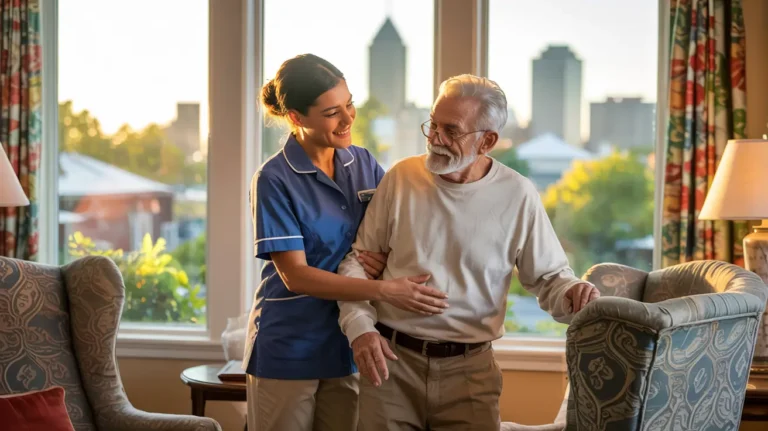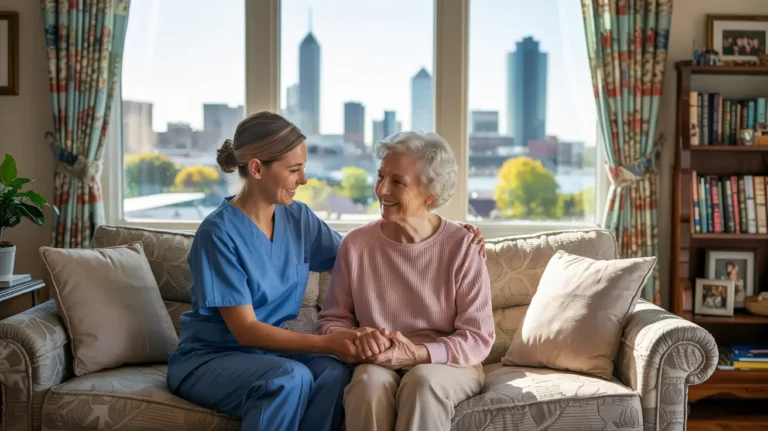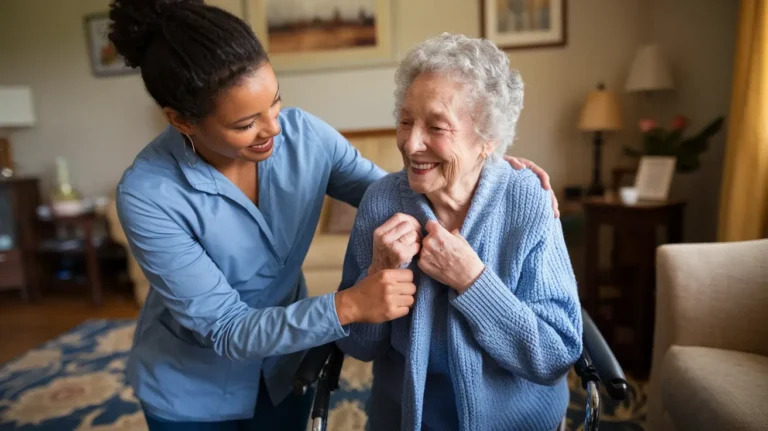Understanding Sundown Syndrome: Expert Care Solutions in Indianapolis
Have you ever noticed your elderly loved one becoming more confused or agitated as the day turns to evening? I remember the first time I witnessed this with my uncle – it was like a switch flipped around 4 PM! This phenomenon, known as sundown syndrome or “sundowning,” affects many seniors with dementia and can leave families feeling helpless and frustrated. Trust me, I’ve been there – watching someone you care about suddenly become anxious, confused, or even hostile as the sun goes down is incredibly challenging. That’s why understanding this condition is so important for caregivers across Indianapolis and beyond. Sundown syndrome affects up to 20% of people with Alzheimer’s disease, creating unique challenges that require specialized approaches. For families struggling with this difficult aspect of dementia care, Brightness Home Care LLC in Indianapolis offers the experience and compassionate support needed to navigate these complicated evening hours.
What Is Sundown Syndrome and Who Does It Affect?
Sundown syndrome isn’t just a fancy medical term – it’s a real struggle I’ve seen families battle day after day. Also called sundowning or late-day confusion, it’s a cluster of symptoms that typically shows up late afternoon or early evening in people with dementia. I’d describe it as a state of increased confusion, anxiety, and agitation that seems to follow the setting sun.
Let me tell you, this isn’t some rare condition either. From my years working with seniors, I’d estimate about 1 in 5 people with Alzheimer’s experience some form of sundowning. But it’s not limited to Alzheimer’s – folks with other types of dementia, Parkinson’s disease, or even those recovering from surgery can experience it too.
I once worked with a family whose 82-year-old mother was perfectly lucid during morning hours but transformed into a completely different person around 4 PM. This pattern is incredibly common, and it’s not just the elderly person who suffers – caregivers take the brunt of it too!
The risk factors aren’t fully understood, but I’ve noticed it tends to be more common in people in the middle stages of dementia. Men and women seem equally affected, though everyone’s experience is unique. Factors like fatigue, low lighting, and disruptions to the body’s internal clock seem to play significant roles.
For caregivers in Indianapolis dealing with sundowning behaviors, the evening hours can become the most dreaded part of the day. I’ve seen the toll it takes – exhaustion, frustration, and sometimes even guilt when patience runs thin. That’s why understanding that these behaviors are part of the condition, not a reflection of your caregiving skills, is so important.
Recognizing the Signs and Symptoms of Sundown Syndrome
Identifying sundown syndrome can be tricky at first – I certainly missed the signs when my mother-in-law started showing symptoms years ago. The most obvious clue is timing. If your loved one suddenly becomes more confused, agitated, or difficult to handle specifically in the late afternoon or evening, sundowning might be the culprit.
The behavior changes can be dramatic! I’ve seen the sweetest, most gentle seniors transform into completely different people as the day progresses. They might become suspicious, demanding, or even combative. One gentleman I cared for would insist that strangers were in his house every evening around 6 PM, though he was perfectly rational earlier in the day.
Sleep disturbances go hand-in-hand with sundowning, and boy, can that create a vicious cycle! When someone isn’t sleeping well at night, they’re more tired during the day, which often makes sundowning worse the next evening. I learned this the hard way after several exhausting nights trying to keep my client from wandering through the house at 2 AM.
The anxiety that comes with sundowning can manifest as restlessness or pacing. Many people with this condition can’t sit still during these episodes – they’ll walk back and forth, fidget constantly, or try to “go home” even when they’re already there. Sometimes this wandering behavior can be dangerous, especially if they try to leave the house unsupervised.
What really threw me for a loop when I first encountered sundowning were the hallucinations and delusions. Some seniors might see things that aren’t there or become convinced of things that aren’t true. One woman I cared for became absolutely certain each evening that someone had stolen her purse, when it was safely stored in her closet.
It’s important to recognize that sundowning symptoms differ from regular dementia behaviors in their timing and intensity. Regular dementia symptoms don’t typically follow a daily pattern tied to the time of day. With sundowning, you can almost set your watch by when the symptoms will start!
7 Proven Strategies for Managing Sundown Syndrome at Home
Let me share some tried-and-true strategies I’ve picked up over the years for managing sundown syndrome. Creating structured daily routines has been a game-changer for so many families I’ve worked with! When Mr. Johnson was experiencing terrible sundowning episodes, we established a strict schedule with meals, activities, and rest periods at the same times each day. Within a week, his evening agitation had decreased significantly. Our bodies crave predictability, especially when dealing with cognitive decline.
Light therapy literally brightened our approach to managing sundowning! I’ve seen remarkable results using light boxes in the morning and ensuring plenty of natural light exposure throughout the day. Then, as evening approaches, we gradually dim the lights to signal the body that it’s time to wind down. I made the mistake once of keeping lights too bright in the evening, and it seemed to make symptoms worse.
Environmental modifications aren’t just fancy words – they’re practical solutions that work! Removing clutter, minimizing noise (especially from TVs or radios in the evening), and creating a calm space can make a huge difference. I remember rearranging Mrs. Wilson’s living room to eliminate shadows and create a more soothing atmosphere – her evening anxiety dropped almost immediately.
Activity planning is crucial, but timing is everything! I learned to schedule more demanding activities earlier in the day when energy levels are higher. By afternoon, we transition to calmer activities like listening to familiar music or simple reminiscing conversations. One big mistake I made early on was planning a family gathering that extended into the evening – complete disaster!
Dietary considerations matter more than you might think. I’ve found that heavy meals or caffeine in the afternoon can worsen sundowning symptoms. Instead, lighter meals earlier in the evening and limiting sugar and caffeine after lunch often helps. My client Tom would have a cup of coffee with dinner and then be up all night – switching to herbal tea made a noticeable difference.
Communication approaches can either escalate or defuse situations. I’ve learned to speak slowly, use simple sentences, and never argue during sundowning episodes. Validation therapy – acknowledging feelings without challenging misconceptions – has saved many difficult evenings. When Mrs. Thomas insisted someone was in her room, arguing only made her more agitated. Instead, I’d check the room with her, validate her concerns, and redirect to a calming activity.
Knowing when to seek professional help is perhaps the most important strategy. If sundowning symptoms become severe or unmanageable, it’s time to contact healthcare providers. They can rule out other medical issues like UTIs (which can cause similar symptoms) or consider medication options when appropriate. Don’t wait until you’re at your breaking point – I made that mistake and ended up exhausted and ineffective.
How Professional Caregivers Address Sundown Syndrome
When I first started working with sundowning clients, I was overwhelmed! But specialized training makes all the difference. Professional caregivers like those at Brightness Home Care receive specific education on sundowning behaviors – not just what they look like, but the biological and psychological factors behind them. I remember my first training session was eye-opening; suddenly behaviors that seemed random made perfect sense!
Consistency is absolutely key when addressing sundown syndrome. Having the same caregiver arrive at the same time each day provides security for someone experiencing cognitive decline. We establish predictable routines that signal safety to the brain. I once covered for another caregiver who did things differently, and the client was noticeably more agitated that evening. Lesson learned!
Personalized care plans aren’t just fancy paperwork – they’re practical tools that work! We track individual triggers, effective interventions, and preferred activities for each client. For example, I discovered that Mr. Davis became much calmer when listening to jazz music in the evening, while Mrs. Henderson responded better to quiet reading time. One size definitely doesn’t fit all with sundowning care!
Documentation and pattern recognition help us constantly improve our approach. We keep detailed records of behaviors, what preceded them, and what interventions helped. Over time, these records reveal patterns that might not be obvious day-to-day. I remember realizing that one client’s agitation increased significantly on days when she had visitors in the late afternoon – a pattern her family hadn’t noticed but that helped us adjust her schedule.
Collaboration with healthcare providers ensures we’re addressing all aspects of sundowning. Professional caregivers work alongside doctors, nurses, and therapists to develop comprehensive care strategies. When Mrs. Wilson’s sundowning suddenly worsened, our documentation helped her doctor identify an underlying UTI that was exacerbating her symptoms.
Family education and support are essential parts of professional caregiving. We don’t just care for the client; we teach techniques and strategies to family members too. I’ve spent hours showing families how to redirect attention, create calming environments, and respond effectively to difficult behaviors. The relief on their faces when they successfully manage a sundowning episode is priceless!
Why Indianapolis Families Choose Brightness Home Care for Sundown Syndrome Support
Let me tell you why Brightness Home Care has become the go-to provider for sundown syndrome support in Indianapolis. Their specialized dementia care training program is seriously impressive! Every caregiver completes intensive education specifically on sundowning behaviors and advanced dementia care techniques. I wish I’d had this level of training when I first started working with dementia clients – it would have saved so many difficult moments!
The consistent caregiver scheduling at Brightness Home Care makes a world of difference for sundowning clients. They understand that familiar faces and routines provide security during vulnerable evening hours. I’ve seen firsthand how clients respond better to caregivers they know and trust, especially during those challenging sunset transitions.
Their person-centered approach isn’t just a buzzword – it’s their whole philosophy! Each care plan is built around the individual’s unique preferences, history, and specific sundowning triggers. One client I worked with loved gardening throughout his life, so we incorporated evening plant care into his routine, which significantly reduced his sundowning anxiety.
The customized care plans for evening hours are what really set Brightness Home Care apart. They develop detailed protocols specifically for the 4-9 PM timeframe when sundowning typically occurs. This might include special lighting adjustments, specific activities, or unique communication approaches tailored to each client’s needs during this critical period.
The resources available for families go well beyond direct caregiving. Brightness Home Care offers family training sessions, support groups, and educational materials specific to sundown syndrome. I remember one family telling me how much stress was relieved once they understood the condition wasn’t their fault and learned specific techniques to manage it.
Being located at 4911 West 38th Street in Indianapolis gives Brightness Home Care unique connections to local support networks. They maintain relationships with local neurologists, dementia support groups, and senior resources specific to Indianapolis. This local expertise means families get connected to exactly the right community resources for their situation.
Creating a Sundowning Care Plan: Step-by-Step Guide
Creating an effective sundowning care plan starts with a thorough assessment of symptoms. I learned the hard way that you can’t develop an effective plan without understanding the specific patterns and triggers. At Brightness Home Care, we track behaviors for at least a week, noting exact times, duration, and intensity of symptoms. This baseline assessment is crucial – I once misjudged a client’s sundowning pattern and scheduled activities at exactly the wrong time!
Identifying triggering factors requires detective work and patience. Common triggers include fatigue, shadows, unfamiliar environments, or disruptions to routine. One client I worked with became severely agitated around 6 PM every evening – we eventually realized it coincided with shift changes at the hospital across the street, which created increased noise and traffic! Finding these specific triggers makes all the difference.
Building the right care team involves matching caregivers’ strengths with client needs. Some caregivers naturally excel with sundowning clients due to their calm demeanor and creative redirection skills. I remember struggling with one particularly challenging client until we matched him with a caregiver whose gentle approach completely transformed his evening experience.
Medication management considerations are an important part of any sundowning care plan. While medications aren’t always necessary, working with healthcare providers to establish appropriate timing for necessary medications can help. I’ve seen cases where simply adjusting medication schedules to avoid peak sundowning hours made a significant difference in behavior.
Establishing calming routines before sundowning typically begins is key to prevention. This might include soft music, gentle massage, or meaningful but low-stimulation activities. With Mrs. Johnson, we developed a 4 PM “tea time” routine with herbal tea and quiet conversation that significantly reduced her evening anxiety.
Planning for emergencies is something many caregivers overlook until they’re in the middle of a crisis! Every good sundowning care plan should include strategies for acute episodes, including specific redirection techniques and contact information for healthcare providers. I once faced a particularly severe sundowning episode and had to scramble to find the doctor’s after-hours number – a mistake I never repeated!
Regular review and adjustment procedures ensure the care plan evolves as needs change. Sundowning patterns can shift over time, especially as dementia progresses. At Brightness Home Care, care plans are formally reviewed monthly, but adjustments are made whenever needed. I remember feeling stuck with a client whose sundowning suddenly worsened until we realized seasonal light changes were affecting her – adjusting our approach to account for earlier darkness made all the difference.
Conclusion
Navigating the challenges of sundown syndrome can feel overwhelming, but you don’t have to face it alone. Throughout my years working with seniors experiencing sundowning, I’ve seen how proper understanding and techniques can dramatically improve quality of life for both the individual and their family. The right approach combines consistency, environmental adjustments, and personalized strategies tailored to each person’s unique needs and triggers.
Brightness Home Care LLC stands out in Indianapolis for their specialized expertise in managing sundown syndrome. Located at 4911 West 38th Street in Indianapolis, their team brings both professional training and heartfelt compassion to each client experiencing these difficult evening transitions. Their approach considers the whole person – not just their symptoms – resulting in care that truly makes a difference during those challenging sunset hours.
If you’re noticing signs of sundown syndrome in your loved one, don’t wait until you’re exhausted and overwhelmed. Reach out to Brightness Home Care on +1 (317) 619-0761 for a consultation about how their specialized sundowning support services can help your family. Their Indianapolis-based team can develop a customized care plan that addresses your specific situation and concerns.
I’d love to hear about your experiences with sundown syndrome. What strategies have worked for your loved one? What challenges are you still facing? Sharing our experiences helps build a stronger community of understanding around this challenging aspect of dementia care.







